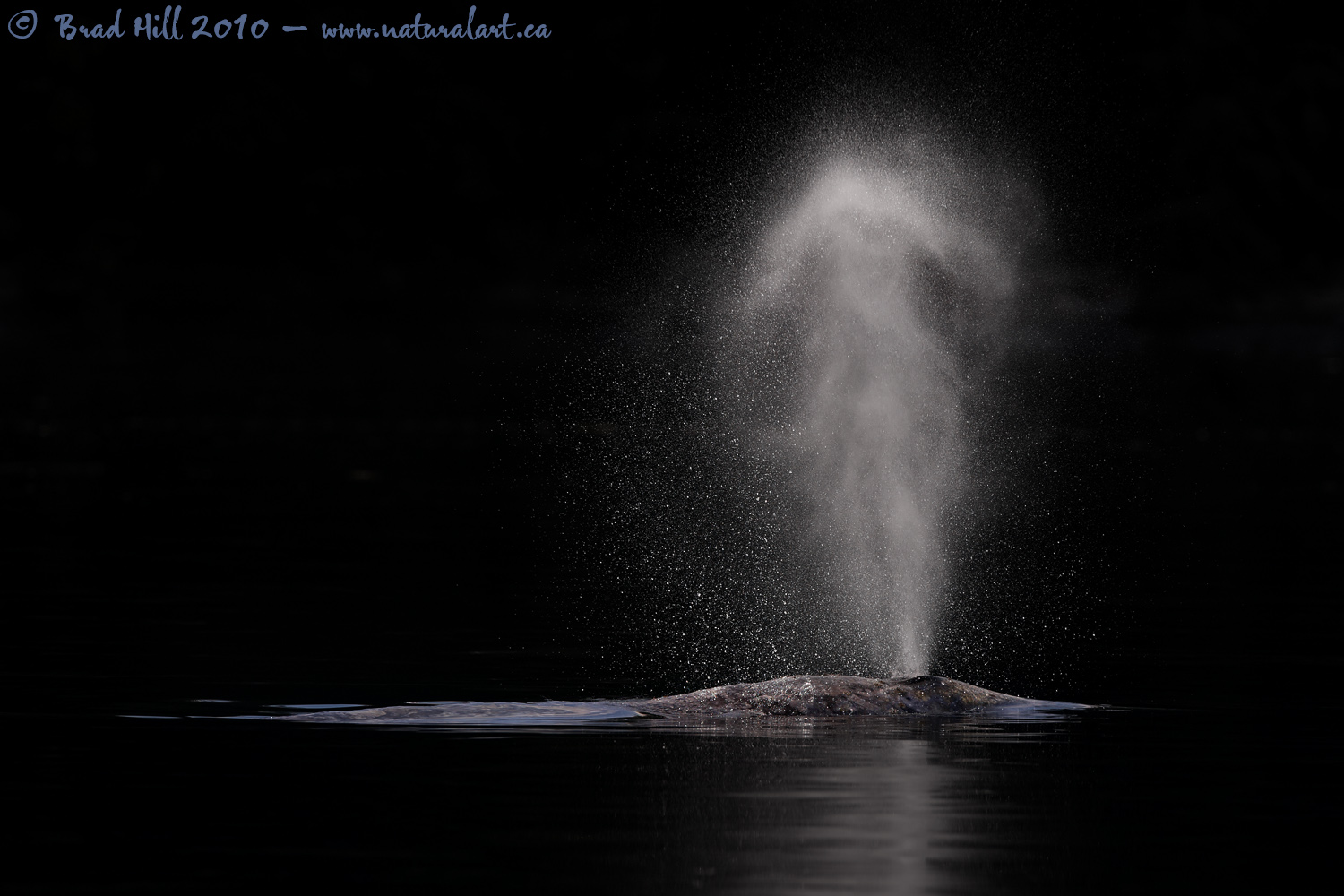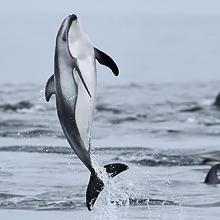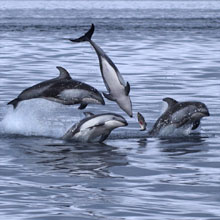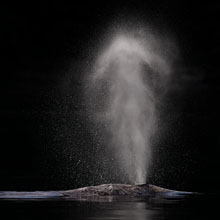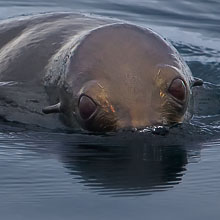Availability: Undetermined - Enquiries?
In the Field
Gray On Black. Northern Vancouver Island, BC, Canada. August 24, 2010.
If you're wondering what this image actually is...it's a Gray Whale doing what gray whales mostly do when they're on the surface - simply exhaling (or "blowing"). These medium-sized whales are bottom feeders that tend to be less "athletic" on the surface than some other species of whales (such as Humpbacks) and actually finding an interesting way to portray them from the surface can be a challenge!
This shot is a bit of a study in minimalism (and it's a real monitor-tester!!). When we encountered the whale we had a patchy light cloud cover, with the sun mostly above the whale but a little behind it. I shot a number of images of the whale when the sun was behind the clouds and the images were...uhhhh...well, to be honest, quite boring! We DID have quite calm water at the time and I started thinking if the sun came out some back-lit fun could be easily had! So...when the sun did come out it illuminated the whale nicely, but threw the background into dark shade. Under these conditions, when the whale blew the plume was extremely bright and super-easy to over-expose (or blow out). So, I decided to "go creative" and intentionally under-expose the bulk of the image (by almost two stops) in order to retain all the detail in the water vapour - and, of course, you can easily see the image of the Virgin Mary in the pattern of vapour ;-). I knew at the time this would leave both the background and the water very dark, which was fine by me! I was planning on making that water and background even darker by post-processing anyway!
So when it came to processing the image, I selectively darkened the already very dark water and background - I backed off the exposure in those areas (only) another 1.5 stops. This had the effect of reducing the image to just a few elements (whale, spout, and a few reflections) and left just a touch of colour in the image, which is exactly what I wanted. Presto - all the distracting elements were gone and I was left with an extremely simple, but (at least to me) very compelling image. Does the image accurately reflect the initial scene? Nope, not much at all. But, all the "manipulations" done to it could have easily be done in a darkroom back in the "good old days" (aka the film era).
The take home lesson? One that I repeat a lot but I still think is missed by many of today's digital photographers: knowing what you can do with an image in post-processing can (and should) influence how you capture those images in the first place. The "Big Feedback Loop" (applying past post-processing lessons to future image capture sessions) is as important - or even MORE important - as the "Little Feedback Loop" we all perform when we review our images on the LCD screens of our cameras and quickly make adjustments to our cameras based on seeing those histograms!
One final comment about the original image capture. When any whale exhales, the velocity of the spray is amazing and normally it's incredibly hard to capture the spout when it's only a meter or two high. In this case we got EXTREMELY lucky because the water was very clear and thus we could watch the whale approach the surface and anticipate when it was about to spray. I used a circular polarizer for these shots, which further cut glare and allowed me to better see the whale and anticipate the action. And, our intrepid guide - who is an amazing wildlife spotter - was also watching the whale as it approached the surface and his "countdowns" helped a LOT - thanks Chris!!
Here's a higher resolution (2400 pixel) version of this spectacular blow - can you see the Virgin Mary in it?
• Gray on Black: Download 2400 pixel image (JPEG: 1.0 MB)
ADDITIONAL NOTES:
1. This image - in all resolutions - is protected by copyright. I'm fine with personal uses of it (including use as desktop backgrounds or screensavers on your own computer), but unauthorized commercial use of the image is prohibited by law. Thanks in advance for respecting my copyright!
2. Like all wildlife photographs on this website, this image was captured following the strict ethical guidelines described in The Wildlife FIRST! Principles of Photographer Conduct. I encourage all wildlife photographers to always put the welfare of their subjects above the value of their photographs.
3. This image was captured during my "Humpback, Orcas, Sea Lions & More" photo tour in August of 2010. Each year I offer trips into two different parts of the Great Bear Rainforest as well as one to photograph aquatic mammals and oceanscapes near the northern tip of Vancouver Island. And, in selected years, I also offer photo tours to locations to capture other highly sought-after subjects, such as various owl species of the boreal forest and wildlife of Canada's Arctic. Details about these trips can be found on the Photo Tours page of this website.
Behind the Camera
Gray On Black. Northern Vancouver Island, BC, Canada. August 24, 2010.
Digital Capture; RAW 14-bit format; ISO 360.
Nikon D3s with Nikkor 400mm f2.8G VR lens - handheld from Zodiac inflatable boat. VR on and set to "Normal" mode. Circular polarizer used.
1/1250s @ f5; -1.7 stop compensation from matrix-metered exposure setting of camera.
At the Computer
Gray On Black. Northern Vancouver Island, BC, Canada. August 24, 2010.
RAW Conversion to 16-bit TIFF, including first-pass/capture sharpening using Phase One's Capture One Pro 5. Two RAW conversions at different exposure settings (one at -1.5 stops for the water in the foreground and the entire background, one at -0.5 stops adjustment for everything else.
Further digital corrections on 16-bit TIFF file using Adobe's Photoshop CS5. Photoshop adjustments included compositing and masking of 2 exposure versions, selective curves adjustment, and selective sharpening for web output.
Conservation
Gray On Black. Northern Vancouver Island, BC, Canada. August 24, 2010.
Ten percent of the revenue generated by this image will be donated to Raincoast*.
Species Status in Canada**: Special Concern (May 2004) - protected in Canada.
The Grey Whale (Eschrichtius robustus) has been driven locally extinct (i.e., extirpated) in Canada's Atlantic waters and is listed as a species of Special Concern in Pacific Waters. It is protected under the Species at Risk Act and a public awareness campaign has been created to assist in reducing the impact of human activities on the Grey Whale. Brochures have been distributed to fishing lodges and park staff to expand the sightings network and motivate people to make behavioural changes that will benefit Grey Whale populations. Additionally, workshops are held to educate kayak guides on proper whale watching guidelines.
Grey Whales are the sole species of the family Eschrichtiidae and differ in many ways from all the other baleen whales, including the fact that they're the only baleen whale that regularly feeds on the bottom of the ocean, normally in shallow, sandy areas. When feeding the Grey Whale rolls onto one side until its head is parallel to the bottom and then acts like a giant vacuum cleaner (the suction is created through the movement of its large muscular tongue) sucking up marine invertebrates living at or just above the bottom.
Grey whales are mid-sized whales of approximately 10 to 15 meters in length and are mottled gray in colour, though concentrations of barnacles and whale lice can give their back a brownish or yellow/orange tint. They annually perform one of the longest migrations of any mammals, traveling over 10.000 km from summer feeding grounds in Arctic waters to shallow water lagoons off Baja California to breed. During this annual trip the Greys encounter a diversity of conditions and jurisdictional boundaries, which complicates efforts at conservation.
*The Raincoast Conservation Society (and Foundation) is an effective and efficient organization that has been fighting for protection of this unique habitat. If you are looking for a meaningful way to contribute to the conservation of this amazing ecosystem, Raincoast will provide maximal "bang" for your conservation dollars.
**as determined by COSEWIC: The Committee on the Status of Endangered Wildlife in Canada












